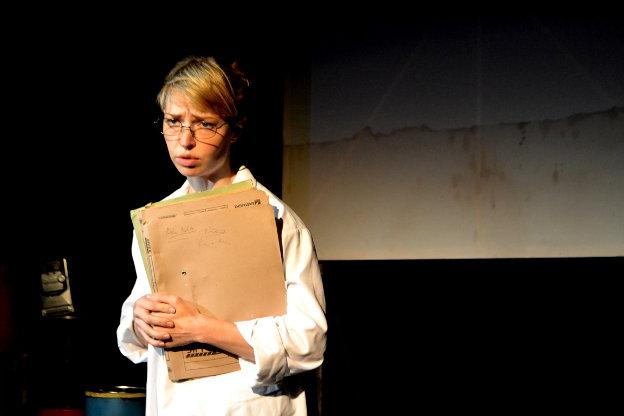It’s always refreshing to see young artists ready to take on the issues of the day – be they political or ethical – bringing them to the stage, and discussing them in a provocative and clever way. NOLA is a courageous play, a verbatim piece that sheds a great deal of light on the subject of the devastating BP oil spill in 2010 in the Gulf of Mexico.
On 20 April 2010 an explosion on the Deep Water Horizon drilling rig killed eleven men, injured seventeen others, and sparked the largest marine oil spill in history. For three months, 4.9 million barrels of crude oil flowed into the Gulf of Mexico and across 125 miles of Louisiana coastline. The state of Louisiana relies on two key industries: seafood fisheries and oil, and both were devastated in very different ways.
The personal stories of loss (of life, of income, of community resources) is at the heart of the piece, which uses the small personal stories as a foundation on which to build the global concerns. NOLA deals with real facts and real people, but of course despite this ‘reality’ we are aware that this is a theatrical construct, a work of art not ‘documentary’. We always have in mind that the storytelling is a reconstruction of memories, and even if told verbatim these memories can be very tricky and unreliable, contaminated with momentary sensations and needs. That said, the very many voices heard – from bereaved father, to fisherwoman activist, to oyster-catchers with no oysters left to catch, to wriggling politicians, to media reporters, to environmental experts, to the wildlife conservationists washing the oil-caked birds – all collectively add up to a very true and real picture.
Despite the serious intent, the art also shines through. We are, for example, captivated by the way that the verbatim interviews are worked into a dramatic structure, just four actors taking on scores of different characters, each with their own distinctive voice and mannerisms. We are affected by the personal stories and tragedies, and by the way each of those people reacted to the terrible events and somehow kept going.
It’s a theatre piece with no dialogue, no linear narrative, and no climax – the climax happens before the beginning of the story, with the accident itself – yet it still works beautifully as theatre. It succeeds admirably in giving us the opportunity of building for ourselves a picture of the whole accident and its terrible consequences. One of the best things about the piece is that it is very economical in showing real images. These, when they appear on the screen at the back of the stage, are like glimpses of a nightmare everyone wants to forget.
The performers are all very sure of what they are proposing – very conscious of a sharp line between interpretation and presence on stage, or between building a character and assuming the manners of a person that has been interviewed.
The only thing that, maybe, could be improved on – or more accurately developed – is the scenography. The stage set is a collection of oil barrels of different sizes, and this seems the most obvious choice rather than the best solution. The play is so sophisticated in terms of its aesthetic and dramaturgical choices that the scenery, in some way, diminishes its potential. It should, because it deserves it, be staged in a much more sophisticated and clean set.
This aside, NOLA is certainly a vivacious and dynamic work that talks about a difficult subject without being boring, and without either berating or patronising its audience.


